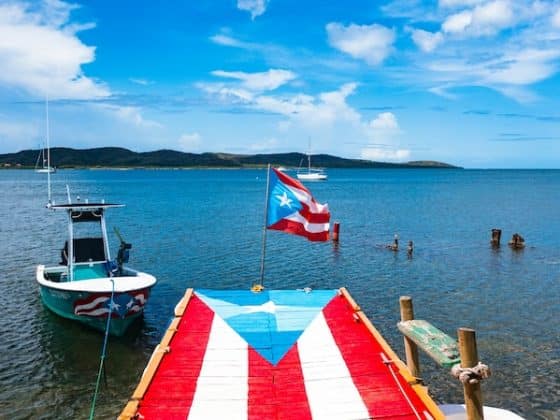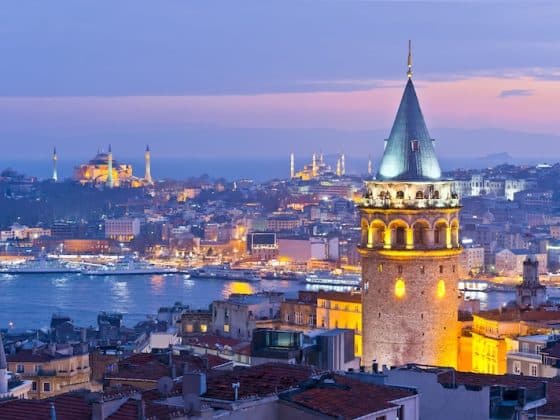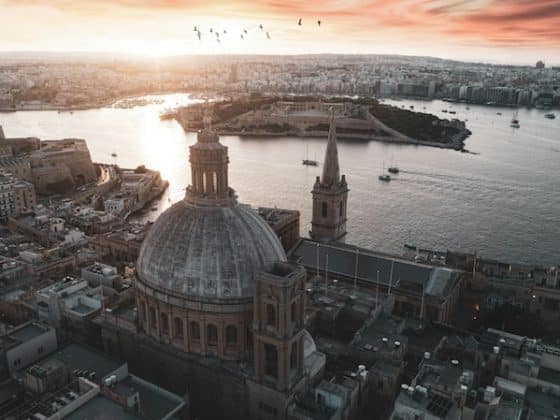Introduction
Thinking about whether the capital of Thailand is the right home base for you? The question of “Is Bangkok a good place to live” is layered but straightforward once broken down. There’s a point when Bangkok starts to seep under your skin. It might happen as you pass through a morning market, the air thick with spice and engine fumes, or while you watch the SkyTrain glide past temple rooftops just as the city lights flicker on. The noise, the heat, the constant movement can feel like too much at first. Then one day, you may notice yourself falling into step with it.
Bangkok is a city of striking contrasts. Golden temples rise beside glass towers. Street food costs less than a cup of coffee but tastes like fine dining. Each day runs on a mix of precision and improvisation, where plans bend to traffic, rain, and the rhythm of daily life.
To live here is to trade predictability for possibility. It can be messy, magnetic, and more rewarding than you imagine.
This article explores what it takes to find a life worth living in Bangkok (from cost and community to culture and daily rhythm) and how this restless city teaches the art of belonging.
What Makes Bangkok Appealing as a Place to Live
Cost of living and housing
In many cities, the cost of comfort defines your lifestyle. In Bangkok, that equation shifts. The essentials (housing, food, daily transport) stretch much further than they would in New York, London, or Sydney. A one-bedroom apartment in the city center averages around US$575 per month, while an apartment outside the center can be as low as US$280. A simple, satisfying meal might cost just US$3.
Living well here often comes down to choice. Some expats build their lives inside modern high-rises with pools and gyms; others rent modest apartments near local markets and rely on tuk-tuks and street food. Either way, Bangkok rewards those who live simply and spend thoughtfully. The comfort of routine and the buzz of adventure coexist in the same block.
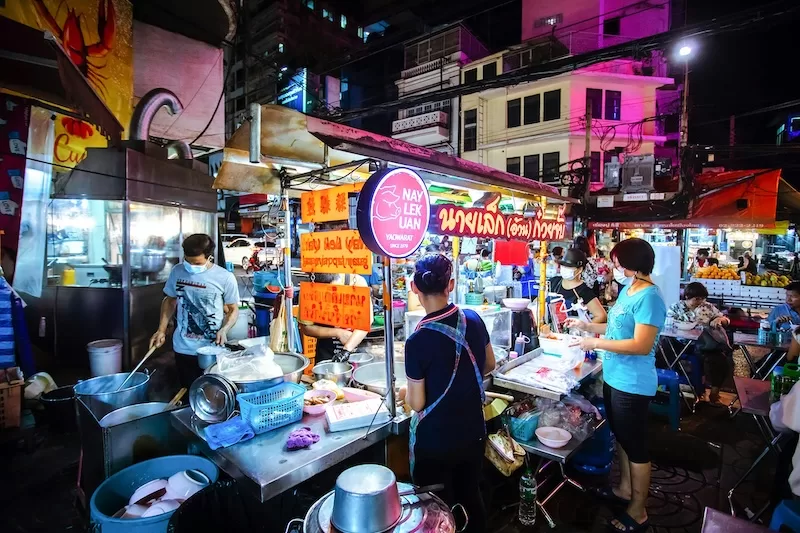
Transport, amenities and urban infrastructure
Ease of movement matters when you live somewhere long term. In Bangkok, the BTS Skytrain and MRT subway carve through the city, linking major neighborhoods and cutting through the dense traffic below.
Together they create a network that feels like a lifeline, connecting the chaos of street markets to the calm of air-conditioned malls and leafy parks. Standing on the platform, you can feel the city’s pulse in the rush of doors opening, the warm air rolling in, and the sight of monks, office workers, and schoolchildren all waiting for the same train.
For those who live near a station, life simplifies. Commutes that would take an hour by car shrink to minutes. The trains run clean and on time, and for a few baht you can glide from a residential block to an international school, a hospital, or a rooftop café. Expansion projects continue to reach further into the suburbs, creating new corridors for people who crave a quieter life without losing connection to the city’s vibe.

What often catches newcomers off guard is how self-contained Bangkok’s condominiums have become. Rooftop pools shimmer in the afternoon heat. Small fitness centers overlook the skyline. Downstairs, there’s usually a café serving iced coffee and a 24-hour convenience store stocked with everything from coconut water to instant noodles. It’s easy to slip into a routine where errands blend into the day. You might grab pad kra pao at midnight from the vendor outside your gate, schedule a doctor’s visit through an app, or order groceries that arrive before the rain does. Beneath all the noise and motion, Bangkok runs with silent efficiency.
Expat community, international schools and healthcare
The expat network in Bangkok is vast and varied. Teachers, entrepreneurs, digital nomads, and retirees all weave into the same urban fabric. Thailand ranked 6th best country in the world for expats in 2024 and much of that reputation begins in its capital. Bangkok makes room for those who arrive curious and willing to adapt. There are networks for nearly every niche: parent meetups, language exchanges, creative circles, business forums. Over time, these gatherings turn the enormity of the city into something that feels almost intimate.
Families often cite the abundance of choice as one of the city’s luxuries. More than 90 international schools offer everything from British and American curriculums to IB programs, each with its own rhythm of uniforms, field trips, and parent communities. Weekends often mean school fairs, park picnics, and exploring new restaurants that cater to families from around the world.
Healthcare forms another thread of reassurance. Bangkok’s private hospitals are known throughout Asia for their professionalism, English-speaking staff, and transparent pricing. Modern facilities, international doctors, and attentive service have made medical visits surprisingly easy to navigate, even for newcomers.
A city once synonymous with short-term travel has matured into a place that sustains long-term lives. Beneath the energy of street markets and skyline bars lies an infrastructure designed for permanence: reliable, human, and far more sophisticated than first impressions suggest.
Key neighbourhoods and housing styles for expats
Central areas – Sukhumvit, Asoke, Silom
At the core of Bangkok, glass towers catch the light as trains glide past long after dark. Sukhumvit (practically built around the Skytrain, you can step out your door and be two stops away from anything you need), Asoke (between Sukhumvit’s energy and Silom’s structure), and Silom (central, walkable and near the river, with quick access to Lumphini Park and key business areas) are Bangkok’s beating heart, places where business, nightlife, and convenience overlap in a single block. Here, mornings begin with espresso in sleek cafés and end with cocktails above the skyline. Luxury condos, embassies, and coworking spaces rise side by side, stitched together by alleys filled with noodle stalls and motorbikes waiting for the next ride.
In Sukhumvit’s Thong Lo, the city turns into something more personal. Trendy yet grounded, it’s a pocket of Bangkok that feels curated without losing its soul. The BTS Sukhumvit Line offers fast connections to the city center while feeling slightly more residential. Wine bars glow behind minimalist facades, and Japanese izakayas spill soft chatter onto the street. High-rise apartments here come with rooftop pools and panoramic views, but the real charm lies in how life happens just below them: easy and spontaneous.
Ari
Ari (also spelled Aree) sits along the BTS Sukhumvit Line, just a few stops north of Siam and Victory Monument. That makes it remarkably central while still feeling residential. You can be downtown in under fifteen minutes, yet walk through streets lined with independent cafés, art studios, and small Thai houses that have been converted into brunch spots.
It’s often described as Bangkok’s creative middle ground, somewhere between the energy of Thong Lo and the calm of Ladprao. Many expats and locals working in design, tech, or education gravitate here because it blends community with convenience.
Ari’s draw isn’t about luxury condos or nightlife; it’s about livability. There are boutique apartment buildings, renovated townhomes, and low-rise condos with rooftop gardens. Markets like Soi Ari 1 sell fresh fruit, flowers, and snacks, while evenings fill with food stalls and soft conversation.
Up-and-coming zones – Ladprao, Rama 9
A few stations outward, the city changes again. Ladprao (now linked to both the MRT Blue Line and the extended BTS Green Line, making it far more convenient than it used to be) and Rama 9 (connected by the MRT Blue Line, and close to the Airport Rail Link at Makkasan) are less polished, more lived-in. Young professionals and digital nomads gravitate here for space, value, and proximity without the constant noise of central Bangkok. Streets are lined with local markets, gyms, and small cafés.
In the mornings, you’ll find breakfast vendors setting up their carts along sidewalks, ladling soup and steaming rice. By evening, the rush fades into the gentle buzz of neighborhood life. These districts are reminders that the city’s real heart doesn’t always sit at its center; sometimes it beats strongest in the places still defining themselves.
Suburban and quieter options
Farther from the skyline, Bangkok gives way to green. In Nonthaburi and Bang Na (sits along the BTS Sukhumvit Line, about 25 minutes from the city center by train, which keeps it well-connected despite its suburban feel), tree-lined streets replace neon, and houses open onto small gardens instead of balconies. Families gather for barbecues and children play in neighborly cul-de-sacs.
The trade-off is time. Commuting can test your patience, but the reward is space, both physical and mental. Schools are nearby, evenings are peaceful, and the city’s chaos feels comfortably distant. For many, these neighborhoods mark the balance they’ve been searching for: close enough to feel connected, far enough to finally exhale.
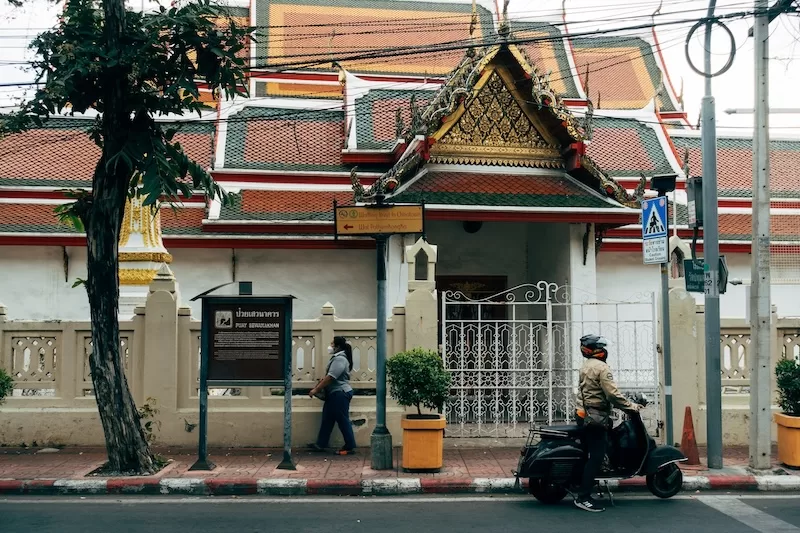
Read More Like This: The Bangkok Condo Market
Choosing Your Bangkok Neighborhood
| Neighborhood | Best For | What It Feels Like |
| Sukhumvit | City lovers who want everything close at hand | High-rise views, rooftop bars, constant motion, and international comfort. |
| Asoke | Commuters who crave connection | Perfectly linked by BTS and MRT, surrounded by cafés, malls, and park trails. |
| Silom | Professionals seeking balance between business and calm | Bangkok’s financial heart with a green escape at Lumphini Park and riverside proximity. |
| Thong Lo | Lifestyle seekers with a taste for design | Sleek apartments, boutique gyms, and Japanese izakayas that hum well into the night. |
| Ari | Creatives, educators, and families craving local flavor | Tree-lined streets, indie cafés, and a sense of belonging that slowly grows over time. |
| Rama 9 | Professionals who want modern value close to the action | A rising business hub with shiny condos, strong transport, and room to evolve. |
| Ladprao | Budget-conscious expats and remote workers | Still local in spirit, now more connected than ever, with honest food and easy pace. |
| Bang Na | Families and long-stay expats balancing work and calm | Suburban comfort with larger homes, good schools, and fast train access to the city. |
| Nonthaburi | Those seeking community and space over speed | Green and grounded, with weekend markets, family gardens, and slower afternoons. |
The challenges of living in Bangkok
Climate, air quality and congestion
Bangkok never hides its climate. The city sits squarely in the tropics, and you feel it from the moment you step outside. Heat wraps around you like a second skin, and humidity lingers well into the night. During the rainy season, storms arrive with little warning, heavy and theatrical, flooding streets within minutes before the sky clears as if nothing happened.
Air quality fluctuates and, at times, ranks among the world’s poorest, a concern for anyone with asthma or respiratory issues. Masks and air purifiers are part of daily life for many locals.
As for the traffic, well, it’s almost legendary. Commutes that should take 20 minutes can stretch far longer. The congestion contributes to the city’s smog, yet it has also shaped a certain resilience. Locals load playlists, sip iced coffee in their cars, and wait it out. The slow crawl has become part of the Bangkok experience. Still, expansion of the BTS and MRT systems continues to chip away at the problem, linking more neighborhoods each year.

Visa, rental processes and regulatory issues
For newcomers, the administrative side of life in Bangkok can feel like learning another language entirely. Thailand’s visa rules are detailed, occasionally shifting, and often layered with new requirements. It takes attention and patience to stay in step. Long-term residents know to check updates often and keep documents organized.
Rental agreements usually run for six or twelve months, with landlords sometimes asking for proof of income or a Thai bank account. Deposits, address registrations, and official forms can seem excessive at first, especially when language barriers complicate the small print. Many expats rely on local agents or bilingual friends to help interpret terms and ensure everything runs smoothly.
Once the paperwork is settled, day-to-day life tends to move with ease. But getting there requires persistence, and a calm approach to bureaucracy. In Bangkok, a polite smile and steady patience often go further than frustration ever could.
Language, culture and integrating into daily life
English will get you through the business districts and tourist corridors, but it fades once you move into local life. Street vendors, utility offices, and government counters often operate entirely in Thai, and the language’s tones can be challenging for newcomers to grasp. A few phrases, spoken sincerely, can open doors that formal paperwork never could.
Cultural understanding is just as important. Thai society values harmony, politeness, and the concept of “saving face.” Conflict or public confrontation is frowned upon, and patience is seen as a mark of respect. Small gestures matter: removing shoes before entering a home, dressing modestly in temples, greeting with a wai rather than a handshake.
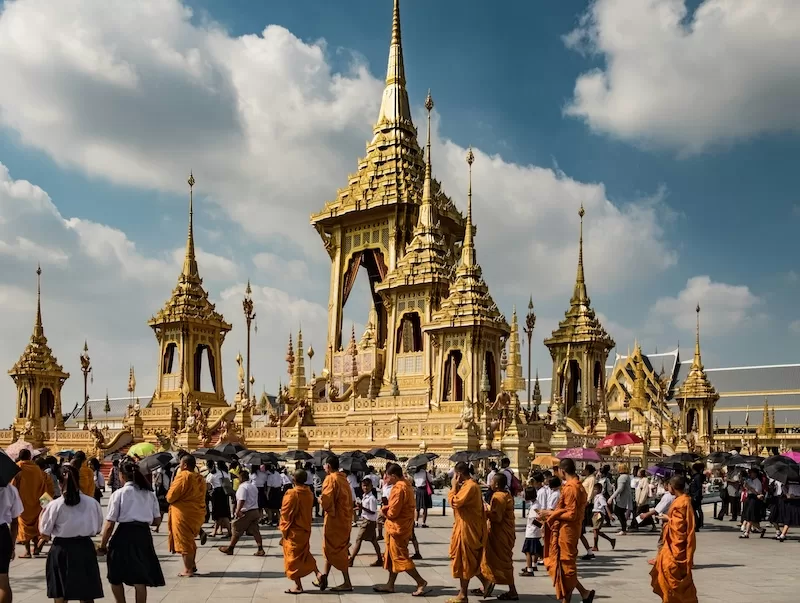
Adapting takes time. Some expats describe it as learning to move more gently through the world. Life becomes easier when you stop trying to make Bangkok behave like home and instead learn its unspoken rules. Integration is not about fitting in perfectly, but about participating with humility and curiosity.
Weather extremes
The warmth that draws people to Thailand can also wear them down. Bangkok’s heat is constant, pressing, and often feels heavier than the temperature suggests. By midday, the air can shimmer, and even a short walk may leave you searching for shade.
Then comes the rain. When the wet season arrives, it does so with drama. Thunder, flickering skies, and streets that transform into shallow rivers before draining away. It can almost be beautiful in its intensity but not always convenient. The air grows thicker, mosquitoes emerge, and umbrellas become an essential part of your style.
Over time, you learn to adapt. Morning walks replace afternoon errands, light clothing dries faster than towels, and rainy days become something to work around. Like much of life in Bangkok, the weather demands flexibility. It is unpredictable, but never dull.
Living in Bangkok as part of a bigger lifestyle plan
Working remotely, digital nomads and time zones
Bangkok has evolved into one of Asia’s most practical hubs for remote work The city offers reliable high-speed internet, a growing network of co-working spaces, and cafés that open early and close late. From Sukhumvit’s sleek office towers to Ari’s indie cafés, the city has every flavor of workspace. The timezone sits comfortably between Europe and Australia, which makes international collaboration easier than in many Southeast Asian capitals. Remote workers can spend mornings on calls, afternoons in meetings, and still have time to explore night markets or riverside bars when the city lights up.
Nevertheless, working here requires discipline. Bangkok is full of distractions: the scent of grilled satay from a street cart, the pull of a last-minute social invitation, the neon streetlights calling for a night out. For digital nomads, the challenge is not connectivity, but focus. Those who find balance often speak of the city as both muse and test: generous, stimulating, and never dull.

Family life, schooling and settling down
For families, life in Bangkok blends routine with exploration. International schools are plentiful, with curriculums that range from British and American systems to IB programs. Many of these schools sit in suburban neighborhoods, surrounded by parks and residential enclaves that give children space to grow.
Weekends bring their own rewards. Families gather in shaded cafés, children chase pigeons in Lumphini Park, and trips to the mall turn into small adventures of food courts and cinemas. Safety and healthcare standards are reassuringly high, peace of mind for parents of any background.
Expats often mention how quickly children adapt. They pick up Thai phrases, develop a taste for mango sticky rice, and navigate the Skytrain with the ease of seasoned commuters. For parents, that kind of adaptability becomes a lesson in what it means to feel at home somewhere new.
Budgeting for lifestyle upgrades
Bangkok can be as affordable or as costly as you allow. The same city that serves $2 meals on the street also offers $200 tasting menus above the skyline. If luxury housing, imported goods and international brands matter, costs climb. The base-cost life may be affordable but tailoring to a Western standard adds up. For example luxury 3-bedroom condos in prime districts may cost US$4,910/month. The key is choice. Bangkok allows you to decide what comfort means to you. Maybe it’s a small apartment near your favorite café, or a family home with a garden outside the center. Quality of life isn’t measured by square meters, but by the freedom to shape your own version of enough.
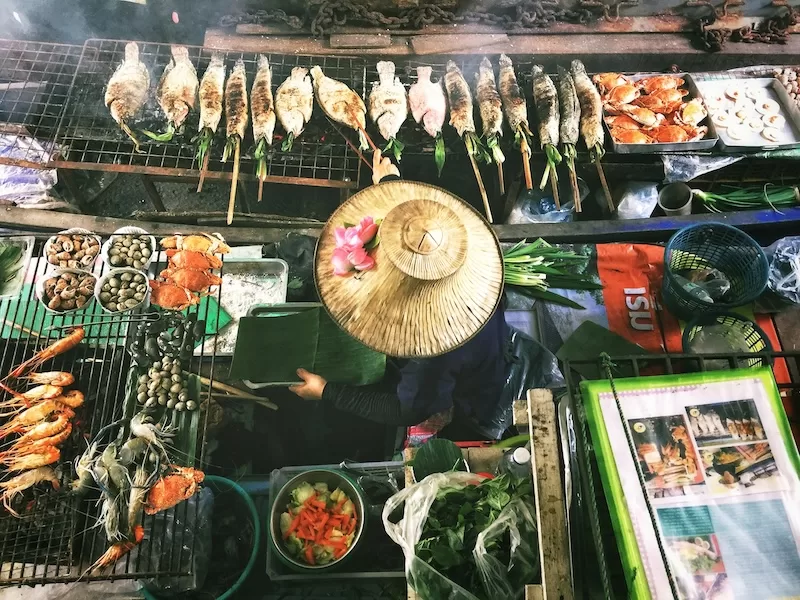
Read More Like This: Why Bangkok is The Best Place to Live in Thailand for Expats
Practical checklist before relocating
Before Bangkok feels like home, there are a few pieces that need to fall into place. Some are logistical. Others are emotional. Together they form the foundation of a life that works as smoothly as the Skytrain on a quiet weekday morning.
1. Explore neighborhoods in person.
Maps and blogs can only tell you so much. Spend time walking different areas before signing a lease. Notice what the streets sound like at night, how the light falls in the afternoon, and how long it really takes to reach the nearest BTS station. The neighborhood that feels perfect online may feel very different once you’re standing in it.
2. Understand your visa inside and out.
Thailand’s visa landscape changes often. Before moving, check the latest updates for your specific category: retirement, work, digital nomad, or education. Keep both digital and paper copies of every document, and make note of renewal dates. In Bangkok, organization is the currency that keeps things running smoothly.
3. Choose housing close to transit.
Traffic is part of life here, but you can outsmart it. Living near a BTS or MRT station can turn hours of commuting into minutes. Think of it as an investment in sanity, not just convenience. The city feels smaller when you can move through it with ease.
4. Budget in both Thai baht and your home currency.
Costs can blur in conversion. Tracking in both helps you see where the money really goes. It also reminds you how far it can stretch, how affordable daily living can be, and where small luxuries add up quickly.
5. Visit healthcare and schooling options early.
If you’re moving with family, research hospitals and schools before arrival. Bangkok’s private hospitals often feel closer to hotels than clinics, and international schools can have waiting lists. A few early visits can save weeks of stress later.
6. Learn the basics of Thai language and etiquette.
Fluency isn’t the goal; connection is. Knowing how to greet someone, thank them, or order food politely earns genuine smiles. Understanding customs (like removing shoes before entering a home or keeping your voice soft during disagreements) helps you feel less like a visitor and more like part of the city.
7. Prepare for the city’s sensory intensity.
Bangkok is a full experience: fragrant, noisy, crowded, and deeply alive. Some days you’ll love the energy; other days you’ll crave silence. Bring patience, a good pair of walking shoes, and a willingness to adjust. That flexibility will serve you far better than anything you pack in a suitcase.
8. Build a network before you arrive.
Online expat forums, coworking communities, and social groups can make the transition smoother. The city is easier to navigate when you already have a few people to share meals, tips, or frustrations with. In Bangkok, community often forms at dinner tables, not desks.
9. Embrace the learning curve.
There will be moments of confusion, either at immigration counters, in supermarkets, or when your taxi takes the scenic route. Laugh when you can, breathe when you can’t, and remember that even locals find the city unpredictable. Adaptability is the real passport here.
FAQs
Q1: Is Bangkok safe for expats?
Yes, by many standards Bangkok is quite safe. Crime rates are generally low though traffic-related hazards and scams targeting foreigners are issues to be aware of.
Q2: How much money do I need to live comfortably in Bangkok?
A single person can live well on around US$2,000 per month, including rent, transport, and food. A modest lifestyle costs less, while high-end living (luxury condos, imported groceries, and fine dining) can push that much higher. Street food, local markets, and public transit keep budgets balanced.
Q3: Can I find English-speaking healthcare and schooling?
Yes. Bangkok hosts many international schools and private hospitals where English is spoken.
Q4: Are all neighbourhoods equally good for expats?
No. Some zones are more conveniently located, developed for expats, better connected by transit; others are cheaper but involve longer commutes or fewer amenities.
Q5: Is Bangkok a good place to retire?
It can be. Warm climate, lower cost of living and good healthcare are positives. But retirement lifestyle needs must include schooling (if family visiting), visa stability, and preference for more relaxed pace outside the busier districts.
Q6: What is healthcare like in Bangkok?
Bangkok’s private hospitals are among the best in Asia. Facilities like Bumrungrad International and Samitivej Hospital are renowned for English-speaking staff, modern equipment, and efficient service. Costs are significantly lower than in the US or Europe, though still higher than public hospitals. Many expats take out international or local health insurance for peace of mind.
Q7: What about transportation beyond the BTS and MRT?
Bangkok’s transport network is layered. The BTS Skytrain and MRT subway handle much of the city’s core movement. For shorter routes, locals use motorbike taxis, canal boats, or Grab (the Southeast Asian version of Uber). The city also has an Airport Rail Link and plans for more lines that will connect to outlying areas like Bang Na and Nonthaburi.
Q8: What are the downsides of living in Bangkok?
The most common complaints are heat, traffic, and air quality. The climate can feel overwhelming during the hot season, and pollution levels fluctuate. Yet many expats say these challenges fade once daily life takes shape and routines adjust around the weather and rush hours.
Q9: Do you need to speak Thai to live in Bangkok?
Not necessarily, but it helps enormously. English is widely understood in restaurants, hospitals, and business districts, but less so in government offices or local markets. A few Thai phrases (greetings, thank-yous, numbers) can turn daily interactions into genuine exchanges.
Q10: How reliable is the internet in Bangkok?
Exceptionally reliable. Broadband speeds average 200–300 Mbps in most neighborhoods, and mobile data is fast and inexpensive. For digital nomads or remote workers, the city’s connectivity is one of its biggest advantages. Co-working spaces like The Hive, Hubba, and True Digital Park make working remotely both social and productive.

Making the Call on Bangkok
For many readers the question of “is Bangkok a good place to live” resolves into yes, it is an excellent base for the right person. If cost control, urban convenience, strong expat-infrastructure and a dynamic lifestyle matter, Bangkok should be high on the list. On the other hand, if quiet suburbia, temperate climate or minimal transit traffic are non-negotiable, then living here will require trade-offs and adaptation. Finding a life worth living in Bangkok is less about escape and more about discovery. Take the time to network, visit the neighborhoods and map your personal priorities. The city will test your patience, then reward your openness. It will overwhelm you, then remind you how to slow down. Over time, the rhythm that once felt chaotic begins to feel like your own heartbeat.
Life abroad is easier when you have the right stories, insights, and community around you. By subscribing to our newsletter you’ll receive thoughtful updates about life in Thailand and beyond, articles written from real experience, new visa and property news, cost-of-living comparisons, and insider tips that help you feel grounded before you even arrive. Subscribe today to start planning your next chapter, one lived with more awareness, freedom, and confidence.

